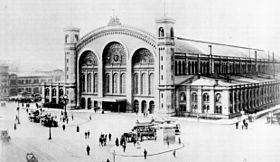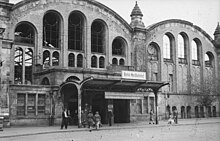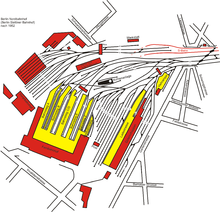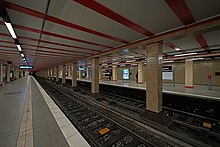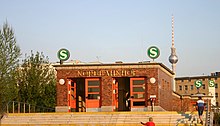Berlin North Station
| Berlin North Station | |
|---|---|
|
Szczecin train station around 1875
|
|
| Data | |
| Location in the network | former terminus (long-distance train) intermediate station (S-Bahn) |
| Design | former terminus station (long-distance train) tunnel station (S-Bahn) |
| Platform tracks | 4 (S-Bahn) |
| abbreviation | BNB (S-Bahn) |
| IBNR | 8089024 |
| Price range | 4th |
| opening |
August 1, 1842 (long-distance train station) July 27, 1936 (S-Bahn station) |
| Conveyance | May 18, 1952 (long-distance train station) |
| Website URL | sbahn.berlin |
| Profile on Bahnhof.de | Berlin-Nordbahnhof |
| Architectural data | |
| architect |
Theodor August Stein (long-distance train station) Armin Wegner (old suburban train station) Günther Lüttich (S-Bahn train station) |
| location | |
| Place / district | Berlin center |
| country | Berlin |
| Country | Germany |
| Coordinates | 52 ° 31 '55 " N , 13 ° 23' 16" E |
| Railway lines | |
|
|
| Railway stations in Berlin | |
Berlin Nordbahnhof (until 1950: Stettiner Bahnhof ) was one of the largest Berlin terminal stations . Until 1952 it was the starting point of the railway line to the Pomeranian Stettin . It was in the north of the city center on Invalidenstrasse in the Mitte district .
In addition to the remains of a building from the suburban train station, there is only the underground Nordbahnhof S-Bahn station of the north-south S-Bahn . It is listed as a BNB in the operating point directory.
history
The long-distance train station
From August 1, 1842, the trains of the Stettiner Bahn in the direction of Bernau , Eberswalde , Angermünde , Stettin and in the following years also from 1863 with the Angermünde-Stralsund Railway to Western Pomerania . In 1878 the Berlin Northern Railway went into operation via Oranienburg , Neustrelitz and Neubrandenburg to Stralsund , which also used the Szczecin train station for passenger traffic. With the Kremmener Bahn a third line was added in 1893, which served as a branch line for local and regional traffic.
As early as 1851, the Stettiner Bahnhof was connected to the Berlin connecting railway , which enabled the exchange of cars with the other Berlin terminal stations Hamburger Bahnhof , Potsdamer Bahnhof , Anhalter Bahnhof and Frankfurter Bahnhof (later: Schlesischer Bahnhof ). However, this traffic was stopped again in 1871 because it disrupted the increasing traffic.
During this time, the expansion and renovation of the Szczecin railway station was tackled, as the facilities could no longer cope with the rapidly increasing traffic volume. At the end of 1876, the new station building was ready for use. The architect was Theodor August Stein , who was also responsible for a number of station buildings on the Angermünde-Stralsund railway. From December 1, 1877, the station also served passenger traffic on the Berlin Northern Railway, which had opened a few weeks earlier, via Neustrelitz to Stralsund.
In the course of raising the railway system, the Szczecin Tunnel , opened in 1896, was created , a pedestrian tunnel as a connection between Schwartzkopffstraße in the Berlin district of Oranienburger Vorstadt and Gartenstraße in the Gesundbrunnen district .
In 1903 the station building was expanded to include three smaller halls on the eastern edge for long-distance traffic. In 1914, long-distance express trains ran from the Szczecin train station in Berlin to Stralsund, Danzig via Szczecin and Rostock . The fastest connection from Szczecin train station to Szczecin took two hours in 1914. In addition, there were combined express train connections for rail and shipping from Berlin, Stettiner Bahnhof via Rostock, Gedser to Copenhagen (Kobenhavn).
During the Second World War , the long-distance station was severely damaged by Allied air raids .
After the recognition of the Oder-Neisse border , the name reference to the Pomeranian port city of Stettin, now in Poland , should be avoided, and so the station was renamed Nordbahnhof on December 1, 1950 during the GDR era . Until then, the name Nordbahnhof had been used for the freight yard of the Nordbahn located further to the east . This was called Eberswalder Strasse station from 1950 . At the same time was Silesian Station in Ostbahnhof renamed.
Two years later, on May 18, 1952, the long-distance station was closed, both because of the war damage and because of the geographical location of the departure route. This led from the station first via the West Berlin station Gesundbrunnen , before reaching the East Berlin urban area again at the border between Wedding and Pankow . The background to this was that from June 1, 1952, the GDR had banned West Berliners from free access to their territory . Three years later it was decided to remove the building and in 1962 the demolition work was completed.
The suburban train station
From 1897, the suburban railway ran from here via Gesundbrunnen to Pankow. For this purpose, to the west, next to the large hall of the Szczecin long-distance train station, a separate, smaller station building, the Szczecin suburban train station (also known as the Kleiner Stettiner ), was built according to plans by the railway construction inspector Armin Wegner . On August 8, 1924, the first electrically operated S-Bahn train left the suburban train station in the direction of Bernau .
After the construction of the north-south tunnel , the suburban station lost its function on July 27, 1936 and was closed. The station building of the small suburban train station in Szczecin on Zinnowitzer Strasse (today: Julie-Wolfthorn-Strasse) had survived the war and the GDR era damaged. In 2011 it was extensively renovated and integrated into the Nordbahnhoffices commercial project that was built next to it . There is an event location in the reception building.
The underground S-Bahn station
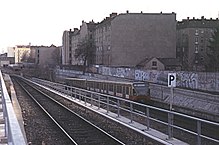
The new S-Bahn station was built underground according to the design of the Reichsbahnoberrat Günther Lüttich to the east of the long-distance station. It was the first station of the north-south tunnel of the S-Bahn, which continued south towards Friedrichstrasse and Unter den Linden . He received his own reception building on Invalidenstrasse. Another access structure to the underground S-Bahn station was built on Gartenstrasse.
Because of the transfer traffic to the long-distance trains and for operational reasons (the station is located at the northern end of the tunnel and had a connection to the S-Bahn depot located above ground), the station was laid out one and a half times the depth with four tracks with two directional platforms. A sweeping system is connected to the north and south of the platforms . The S-Bahn depot could be reached crossing-free via the northern sweeping system via a switchback.
The two central platforms are each 157 meters long and a maximum of 10.5 meters wide. The platforms are connected by stairs with the underground cross aisles built above the tracks, which formerly continued under the long-distance platforms; A tunnel for baggage handling was created above the northern end of the platform, which is connected to the platforms by an elevator. A relatively spacious pavilion was built as the main entrance to the station.
The Berlin construction method was used for the underground platform hall . With ivory-colored tiles clad hall by three red-clad rows of columns in four vessels divided, wherein the outer rows of supports occupy the platform axis and the inner row between the tracks is. The column chapters or base points are indicated abstractly by recesses in the cladding. The double T-beams of the ceiling were emphasized in color. Although the station was designed under National Socialist rule , the style of the simple and matter-of-fact interior is definitely modern .
Shortly before the end of the Second World War , on April 21, 1945, operations ceased. As a result of the north-south tunnel on the Landwehr Canal being blown up on May 2, 1945, the S-Bahn station was also under water. Until the station was reopened on January 31, 1946, the S-Bahn trains coming from the north drove into the above-ground long-distance station and ended there.
The tunnel station was closed to passenger traffic during the existence of the Berlin Wall and became a so-called “ ghost station ”, which the trains passed through without stopping. Operationally, however, the station continued to be important until the Berlin transport company took over the S-Bahn network in the western part of Berlin in 1984. Up to this point in time, some of the trains running there were used by the S-Bahn depot Nordbahnhof (Bw Nob) , which was located in the eastern sector but was operationally part of the western network.
After reunification
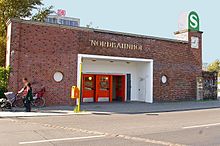
Shortly after the reopening of the S-Bahn station on September 1, 1990, the north-south tunnel had to be closed due to extensive renovation measures. After a year and a half of construction, the tunnel and the underground north station were reopened on March 1, 1992.
After the restart, the entrances to the underground north station were gradually reopened. The train station has been renovated in accordance with listed building standards and a bright elevator and bicycle storage room has been added. The last structure to be reopened in May 2006 was the former northern platform access in Richard Brademann's slightly expressionistic design language at the new tram stop . This entrance previously served as access to special platform G of the Szczecin train station. From here all " KDF trains" went to the Baltic Sea resorts .
Since 2005, more than 2000 Deutsche Bahn AG employees have been working in the newly built office buildings of the Stettiner Carré on the site of the former Szczecin suburban train station . In 2011, this location was expanded to include the Carré Nordbahnhof , with a further 1,300 workplaces, and forms the largest Deutsche Bahn office location in Germany.
In connection with the construction of a new tram stop, the Berlin Senate Administration had the station forecourt redesigned in 2006. Between the old railroad tracks, which were embedded flush in the new pavement, some names of the cities in Pomerania and on the Baltic Sea that were formerly accessible by the Szczecin Railway - in their German and possibly also their Polish form - are inscribed in the square.
Since August 2016, train handling has been carried out by the drivers using a driver's cab monitor (ZAT-FM).
The building of the former Ntm signal box at the northern end of the station area at Grenzstraße was demolished in June 2018.
In the northern distribution level of the S-Bahn station there is an exhibition with photos and videos of GDR border security devices in Berlin underground and S-Bahn stations.
Connection
There are transfer options to two bus and three tram lines. A currently only planned underground line between the main station and Marzahn is to connect the north station.
| line | course | Tact |
|---|---|---|
| M8 | Ahrensfelde / city limits - S Springfuhl - S Landsberger Allee - Landsberger Allee / Petersburger Straße - U Rosa-Luxemburg-Platz - U Rosenthaler Platz - S Nordbahnhof - U Naturkundemuseum - S + U Hauptbahnhof - Mitte, Lüneburger Straße / Mitte, Clara-Jaschke- Street | 10 min |
| M10 | S + U Warschauer Strasse - U Frankfurter Tor - Landsberger Allee / Petersburger Strasse - U Eberswalder Strasse - U Bernauer Strasse - S Nordbahnhof - U Naturkundemuseum - S + U Hauptbahnhof - Mitte, Lüneburger Strasse / Mitte, Clara-Jaschke-Strasse |
5 min
at night: 15 min |
| 12 | Weißensee, Pasedagplatz - Antonplatz - Prenzlauer Allee / Ostseestrasse - U Eberswalder Strasse - Brunnenstrasse / Invalidenstrasse - S Nordbahnhof - U Naturkundemuseum - U Oranienburger Tor - S + U Friedrichstrasse - Mitte, Am Kupfergraben | 10 min |
| 247 | U Leopoldplatz - U Nauener Platz - Nettelbeckplatz / S Wedding - S Humboldthain - S + U Gesundbrunnen - Gesundbrunnen, Wolliner Straße - U Bernauer Straße - U Voltastraße - S Nordbahnhof | 20 min
(U Leopoldplatz - Wolliner Straße 10 min) |
| N40 | Friedrichshain, Wühlischplatz - S Ostbahnhof - S + U Jannowitzbrücke - S Hackescher Markt - U Weinmeisterstraße - U Rosenthaler Platz - S Nordbahnhof - U Naturkundemuseum - S + U Hauptbahnhof - U Turmstraße | 30 min (only at night) |
literature
- Architects and Engineers Association of Berlin (ed.): Berlin and its buildings, Part X Volume B: Systems for traffic (2) Long-distance traffic. Berlin (West) 1984, ISBN 3-433-00945-7 .
- Carl Bathmann: The development of the railway systems in the north of Berlin since 1890 . In: Zeitschrift für Bauwesen , Vol. 53 (1903), Sp. 283–290, 479–496, panels 33–40, digitized version of the Central and State Library Berlin (ZLB).
- Carl Cornelius: Conversion and extension of the reception building at the Szczecin train station in Berlin . In: Zeitschrift für Bauwesen , Vol. 54 (1904), Sp. 213–224, Tafeln 21–23, digitized version of the ZLB.
- Günther Lüttich: New buildings of the Reichsbahn at the Stettiner Bahnhof in Berlin . In: Zentralblatt der Bauverwaltung , vol. 57 (1937), pp. 805–811; see.Entry in the Berlin State Monument List .
- Jürgen Meyer-Kronthaler, Wolfgang Kramer: Berlin's S-Bahn Stations - A Three-Quarter Century. Berlin-Brandenburg 1999, ISBN 3-930863-60-X , p. 198 and p. 294-295.
Movies
- Mysterious places - the north train station. Travel temple and ghost station. Documentary, Germany, 2019, 44:14 min, script and director: Lutz Rentner, camera: Michael Schmidt, production: Noahfilm, rbb , series: Mysterious Places , first broadcast: November 12, 2019 on rbb television , summary by rbb, online Video available until November 8, 2020.
Web links
- Entry in the Berlin State Monument List with further information (Szczecin suburban train station, reception building)
- Berlin Nordbahnhof on stadtschnellbahn-berlin.de
Individual evidence
- ↑ Station price list 2020. In: Deutsche Bahn. Deutsche Bahn, January 1, 2020, accessed on July 11, 2020 .
- ^ Map of the Reichsbahndirektion Berlin 1953 . Retrieved December 14, 2018.
- ↑ News in brief: S-Bahn . In: Berliner Verkehrsblätter . No. 9 , 2011, p. 175 .
- ↑ Waiting hall Berlin. Retrieved on February 4, 2020 (German).
- ^ Susanne Dost: Richard Brademann: 1884-1965: Architect of the Berlin S-Bahn , Verlag B. Neddermeyer, Berlin 2002, ISBN 3-933254-36-1 , p. 206.
- ↑ News in brief - S-Bahn . In: Berliner Verkehrsblätter . No. 10 , 2016, p. 203 .
- ↑ News in brief - Railway . In: Berliner Verkehrsblätter . No. 11 , 2018, p. 231 .
